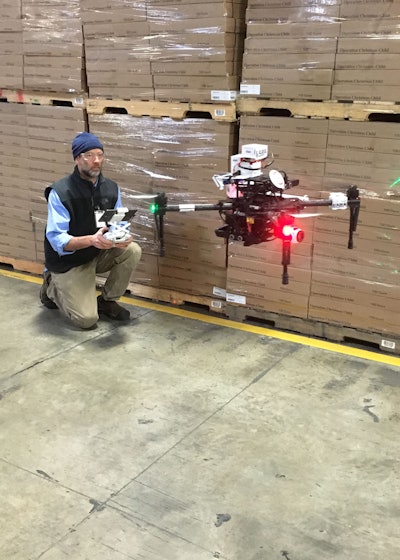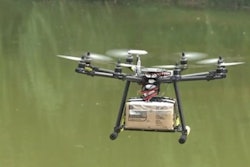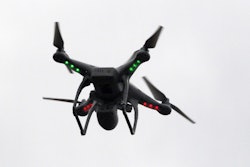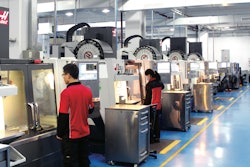
Forget delivery by drones. Experts are now suggesting companies experiment with deploying unmanned aircraft systems (UAS) in their own airspace before even attempting to deliver directly to the consumer.
Efforts by leading retailers like Amazon and Wal-Mart are well underway, with The New York Times reporting in June 2016 that Wal-Mart began testing the use of flying drones to handle inventory at its large warehouses, which supply thousands of stores throughout the nation.
Currently, the company performs its inventory cycle-counting process manually through scanning pallets and handheld scanning devices, which the company tells The New York Times takes about a month, whereas the use of a drone would bring its cycle down to just days.
While these retail giants have the resources to dedicate to drone experimentation for their own personal gain, others are leading the way in drone development as a commercial solution.
In fact, third-party logistics provider Kenco Management Services created an entire department dedicated to giving its customers a look into the future of logistics. Titled Kenco Innovation Labs, the test center doesn’t invent or develop new technology, but works with people who are already doing it well.
“There’s three of us in there, and it’s our job every day to work and think about the future of logistics. Not what sort of solutions can we buy today off the shelf, but what sort of things do both we and our customers need to be keeping our eye on as it relates to six months away, a year away, even so far as five years away,” explains the lab’s innovation research manager and resident drone expert Matt McLelland.
With that in mind, the lab teamed up with a number of small companies to explore the use of drones to manage warehouse systems and yard operations. “As the drone guy in our group, this was one of the things that we saw coming very fast and furious—not just in our industry, but in a wide variety of others as well,” he says. “What we found early on, with respect to other industries like agriculture, and oil and gas, was that logistics wasn’t really doing much.”
In 2013, Amazon CEO Jeff Bezos introduced Prime Air, which was his solution to last-mile delivery. The announcement lit a spark throughout the supply chain, specifically among logistics providers, and “that was kind of the first time logistics people ever really started talking about drones,” notes McLelland.
And according to a new study by PricewaterhouseCoopers (PwC) on the commercial applications of drone technology, titled “Clarity from Above,” the conversation is just getting started. PwC estimates the emerging global market for business services using drones is valued at over $127 billion, with applications in infrastructure, agriculture and transport having the best prospects.
Kenco currently is partnered with two small companies that are experimenting with ways to use drones for inventory cycle counts and another startup tackling the problem of autonomous indoor flight.
The first, PINC Solutions, teamed up with Kenco to explore the use of drones in yard management. Currently, the way it keep its yards up to date is with a human driver in a truck with a wand, who scans RFID tags attached to the sides of trailers.
“Some of these warehouses, these distribution centers have giant yards with hundreds of trailers. That job can take a while, so [PINC] asked, ‘Why don’t we put a drone in the air to fly about 10 feet above all these trailers?’” McLelland explains. “The drone would have an RFID reader that could read the tags, making the job a little bit better, faster, cheaper, but more importantly, it could be completed more frequently. And if we’re able to fly more frequently, then there’s value in more up-to-date data.”
Outside of its partnership with Kenco, PINC is developing a drone to be used inside the warehouse for cycle counting. Traditionally, a full cycle count (checking to see that inventory the system says is located in certain slots is really there) is a tedious job, requiring the help of 10 to 15 people. Drones could make this process more efficient by finding lost pallets and slots that are supposed to be full, but are currently empty.
McLelland is not privy to information in regard to PINC’s indoor drone, but he estimates the solution may be ready commercially by the end of the year.
The second company Kenco is working with is DroneScan, a small South African company that offers the only commercially available indoor scanning solution on the market today. It assists with cycle counting indoors, using a manually controlled drone to scan items higher up on a rack in certain types of warehouses, so that a human can be scanning at ground level within the full reach of his or her arm.
Kenco’s third partnership is with a Chicago startup that is working toward solving the puzzle that is autonomous flight by drone.
“What it wants to do—and really what the entire industry wants to do—is find a way for these things to fly themselves rather than have people flying them manually,” McLelland says.
Kenco’s lab is in the very early stages of working with this company, but McLelland says they are making some real headway on a solution to the problem. He is hopeful that autonomous flight will be resolved within the next year.
Limitations
Moving from a manually controlled drone to a completely autonomous system is one of the largest challenges companies see when considering drone technology within the warehouse for a number of reasons. Like most things cost is a driving factor, as hiring somebody to manually operate a drone is more expensive than the average warehouse worker.
“Until somebody can get around the problem of autonomous flight, somebody's got to fly these things, and it's more expensive to pay somebody to do that task (in a new way) than it is to hire an employee to do it the way we've always done it,” McLelland says.
Manual operation is not the only factor driving cost, however. The idea that drones could replace human workers is only half true, as the jobs drones could execute would transform into news jobs for the people the device is replacing.
“There’s no such thing as a drone technician, but companies are going to need somebody that understands how to work on these things and people to fix them, troubleshoot them, repair them, because these things are somewhat fragile; it's not like a giant forklift that can hit the side of a building and still operate.
“These things are expensive, so there are a lot of cost concerns because these are relatively fragile devices,” McLelland adds.
Drones also are limited due to constraints in weight and battery life. Unless it is massive, a drone can only lift and carry about five kilograms—and you can’t have a huge drone flying around inside a warehouse.
Battery life may be one of the largest complications from a purely technology perspective, because not only does the drone itself draw energy from a battery, but every system on the device is powered by battery. A drone’s flight time depends on a number of factors, including the size of the drone, the size of the battery, the types of systems running on it and whether they are processing programs such as optical character recognition used to do barcode scanning, whether its running a Wi-Fi device so that it can communicate to the Cloud, or if it has a camera.
“Everything that runs requires battery life, and so I think that battery technology is going to have to take another leap forward before we can start getting the flight times out of these things that make them practical. That's probably the biggest problem that I see,” adds McLelland.
So between the struggles with weight and battery life, the idea of drones moving objects around a warehouse is still the stuff of science fiction. “I always get a big kick when I see some kind of clipart that shows a box underneath a drone flying through a warehouse. That just doesn't happen; it can't happen. The laws of physics don't work like that,” McLelland says.
He does note, however, the idea is not that far off. He sees a futuristic warehouse, where drones fly freely lifting boxes or moving equipment around, coming to fruition in the next two to three years.
Regulations
You can explore, experiment and test all you want, but when it comes down to it, one of the biggest questions still on everyone’s mind is: “How are regulations going to affect the use of drones for commercial use?”
There is little disagreement about the dangers of unmanned aircraft, making the cautious approach to regulation understandable. Reports of errant drone flights—a handful of which were crashes or near misses with planes or helicopters—rose more than 50 percent from January through September 2016, and there were 1,367 drone-safety reports to the Federal Aviation Administration (FAA) in that nine-month period, the agency reports.
And while the FAA liberalized restrictions on commercially used drones last summer, in most cases they still can’t be flown directly over people or for long distances. The agency had planned by the end of 2016 to unveil a proposal to allow drone flights closer to people, but that has been delayed over security concerns.
For the Amazon’s of the world, these restrictions are damning, but for those interested in keeping drones indoors, the FAA has no say. The agency has no control over the airspace within a company’s private property, and so far, no regulations are projected for enclosed flight. But legal concerns still exist, McLelland warns, especially in regards to insurance companies and the Occupational Safety and Health Administration (OSHA).
“You can do whatever you want to within your own four walls. Now, the problem there is, what about OSHA, and what about insurance? What are they going to have to say about it, and at the moment we're just not sure,” he says. “If there was some sort of an accident, and OSHA came in and did an inspection, we're just not sure what their official response is to this or what sort of extra precautions and safety regulations need to be in place in order for this to happen.
“I think that a lot of companies, both people purchasing these solutions but also developing these solutions, want a little bit more clarity from the insurance industry on how difficult they are going to make it for potential customers to operate these types of things? That's another concern we need to be on the lookout for,” McLelland adds.
Another hot topic of discussion amongst industry leaders focuses around the Trump administration’s promise to reduce regulation for businesses by up to 50 percent.
“We don't really know what that means; that could mean anything. But, if you take him at his word, it could mean that he is going to make OSHA relax a lot of their regulations that are unclear, and it could affect (drone regulation),” McLelland says. “I'm not saying that it will, but the president of the United States said that it was on his agenda to reduce regulation that currently makes it expensive and difficult for companies to do work within the United States, and I don't think it's unreasonable to think that drones aren't going to be some part of that.”
Safety Concerns
A warehouse is a busy place with many obstacles that can upset a drone’s flight path. There are people, machines and objects constantly moving around, as well as giant fans with what look like propellers hanging from the ceiling. These fans create air currents, which can alter the way drones behave when flying through the air.
This environment creates many general safety concerns, which play a part in the industry’s distrust of the technology.
“I think that we're being a little bit more cautious with drones because nobody is really willing to make a big capital investment until they're reasonably sure that OSHA's not going to say you have to pay a million dollars of liability insurance before you can even turn one of these things on, and then that shuts the whole thing down,” McLelland says. “I think people are a little bit cautious moving forward, especially vendors and people who are developing the solutions, because who wants to sink millions of dollars into developing a new technology that ultimately the government says you can't use?”
McLelland’s gut tells him that if OSHA were to implement a drone standard it would look similar to those that address heavy machinery safety.
“If OSHA were to do anything, my guess is they would come out with some kind of a standard or certification like what we have with forklifts or other pieces of equipment that are very dangerous and large and expensive and have the potential to do harm; I think that we're going to have to have regulations or certifications where somebody's certified to fly an object just like they're certified to drive a forklift.”
Tomorrow's Outlook
Kenco’s partners are not the only companies working on solutions for drones in the logistic space, but McLelland says there are probably less than seven—and so far, everyone is still in the testing stage.
“I have yet to meet anybody in the United States that is using a drone as part of their daily operations for a traditional warehouse type industry,” he says, noting other industries, however, are farther along in the integration of UAS technology. Today, drones are being used across every vertical market—from filming to agriculture to real estate.
It is well-known that the supply chain tends to resist change, but innovation can’t be ignored forever. Much like autonomic vehicles or robotics, which companies are just now beginning to embrace, drones it seems are here to stay. Kenco Innovation Lab’s partner PINC is leading the charge in innovative solutions for drones outside of the last-mile delivery conundrum despite the reservations of their peers. At this time, their barcode scanning drone is successfully working with a handful of customers, mostly overseas, though McLelland was not able to comment on specifics.
“The kind of person that's buying their kit right now is more of a do-it-yourself-company. The ROI (return on investment) on these things is not quite there yet…so the kind of customers they're working with are people who understand they're not necessarily going to be able to do it better, faster, cheaper, but they still want to be able to one of the first ones to do it. They want to be prepared and trained and comfortable with it when the next version of it comes out.”
A study completed by Gartner, Inc. titled, "Forecast: Personal and Commercial Drones, Worldwide, 2016,” claims the global market revenue for the production of personal and commercial use drones will increase 34 percent to reach more than $6 billion in 2017, and grow to more than $11.2 billion by 2020. The study estimates 3 million drones will be produced in 2017, which is about 39 percent more than 2016.
The report states that though delivery drones continue to capture the attention of the news media, they will not be a major factor for several years, because like McLelland alluded, the ROI has not been proven either in regard to the cost of the drone, operational costs and a single customer delivery.
"Delivery drones will be mired in logistical issues like the time needed to return a drone to its origin point after delivery, and will amount to less than 1 percent of the commercial market by 2020," says Gerald Van Hoy, senior research analyst at Gartner. "We expect that delivery drones will begin finding a niche in business-to-business applications first, particularly for internal services within one company where logistics will not be such a big factor."
And McLelland tends to agree.
“By the end of this year, you're going to start seeing this idea of a modern warehouse with drones…and by the end of 2018, we will see drones receiving instructions and being able to simultaneously carry out a task, working in conjunction with each other. I see a solution by the end of 2018 just based on the speed at which all this is going becoming commercially available.”


















